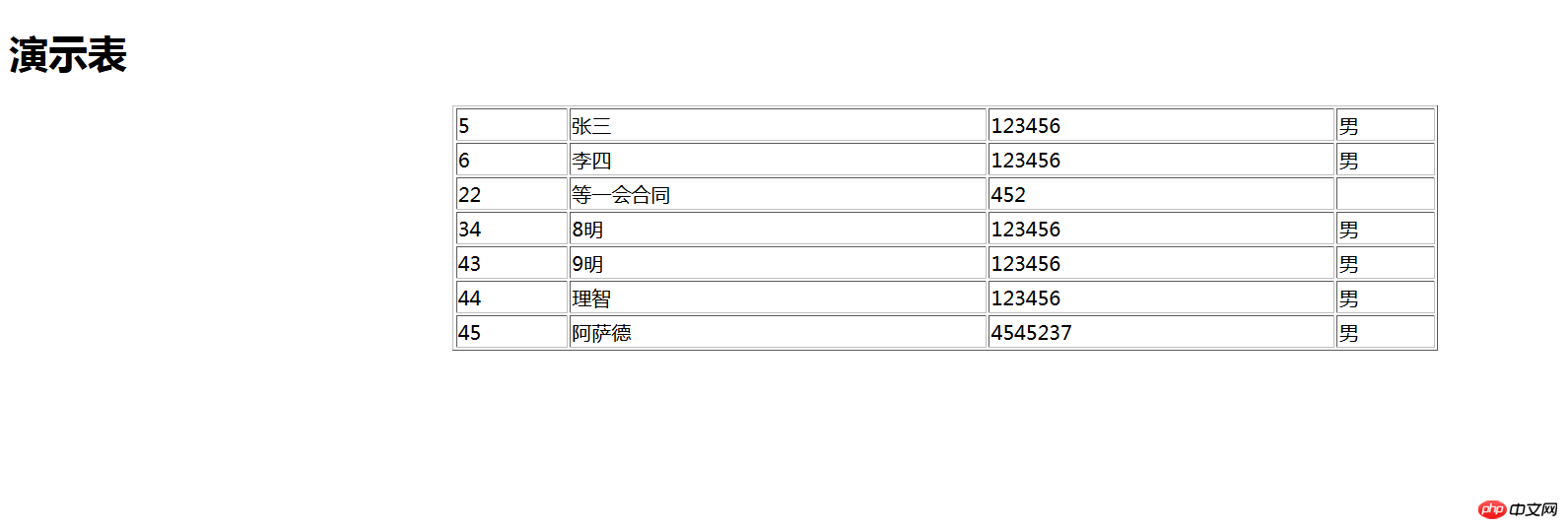
The following editor will bring you an article on how to obtain the database result set in PHP (recommended). The editor thinks it is quite good, so I will share it with you now and give it as a reference for everyone. Let’s follow the editor and take a look.
PHP often needs to access the database to advance the data in the database, so how to advance the data?
The code to extract the database is as follows:
<?php
include("conn.php");//数据库连接
$sql="select* from study_sql";//查询数据库表名为study_sql所有的数据记录
$res=mysql_query($sql);//向数据库发送一条sql语句
//$arr=mysql_fetch_row($res);//获取数据库中的第一条信息
echo '<table apgn="center" width="800" border="1">';//获取的数据用表格显示出来
echo '<cabtion><h1>演示表</h1></cabtion>';
while($arr=mysql_fetch_assoc($res)){//取出表study_sql中的所有结果集
echo '<tr>';
foreach($arr as $col){//遍历数据
echo '<td>'.$col.'</td>';
}
echo "</tr>";
}
?>
##Commonly used SQL functions are as follows:
mysql_affected_rows — Get the number of record rows affected by the previous MySQL operation mysql_cpent_encoding — Return the name of the character set mysql_close — Close the MySQL connection mysql_connect — Open a connection to the MySQL server mysql_create_db — Create a new MySQL database mysql_data_seek — Move internal results Pointer mysql_db_name — Get result data mysql_db_query — Send a MySQL query mysql_drop_db — Drop (delete) a MySQL database mysql_errno — Return to the previous one Numeric encoding of error messages in MySQL operationsmysql_error — Returns the text error message generated by the previous MySQL operationmysql_escape_string — Escapes a string for use with mysql_querymysql_fetch_array — Get a row from the result set as an associative array, or a numeric array, or both mysql_fetch_assoc — Get a row from the result set as an associative array mysql_fetch_field — Get the column information from the result set and Returned as an object mysql_fetch_lengths — Get the length of each output in the result set mysql_fetch_object — Get a row from the result set as an object mysql_fetch_row — Get a row from the result set as an enumeration Array mysql_field_flags — Get the flags associated with the specified field from the result mysql_field_len — Return the length of the specified field mysql_field_name — Get the field name of the specified field in the resultmysql_field_seek — Set the pointer in the result set to the specified field offset mysql_field_table — Get the table name where the specified field is located mysql_field_type — Get the type of the specified field in the result set mysql_free_result — Release result memorymysql_get_cpent_info — Get MySQL client informationmysql_get_host_info — Get MySQL host informationmysql_get_proto_info — Get MySQL protocol informationmysql_get_server_info — Get MySQL server information mysql_info — Get the latest query information mysql_insert_id — Get the ID generated by the previous INSERT operation mysql_pst_dbs — List All databases in the MySQL servermysql_pst_fields — List the fields in the MySQL resultsmysql_pst_processes — List the MySQL processesmysql_pst_tables — List the tables in the MySQL databasemysql_num_fields — Get the number of fields in the result set mysql_num_rows — Get the number of rows in the result set mysql_pconnect — Open a persistent connection to the MySQL server mysql_ping — Ping a server connection, or reconnect if not connected mysql_query — Send a MySQL query mysql_real_escape_string — Escape special characters in a string used in an SQL statement, taking into account the connection Current character setmysql_result — Get result datamysql_select_db — Select MySQL databasemysql_set_charset — Set the client’s character setmysql_stat — Get the current system status mysql_tablename — Gets the table name mysql_thread_id — Returns the ID of the current thread mysql_unbuffered_query — Sends a SQL query to MySQL without retrieving and caching the result rowsThe above is the detailed content of Detailed explanation of php obtaining database result set instance. For more information, please follow other related articles on the PHP Chinese website!




